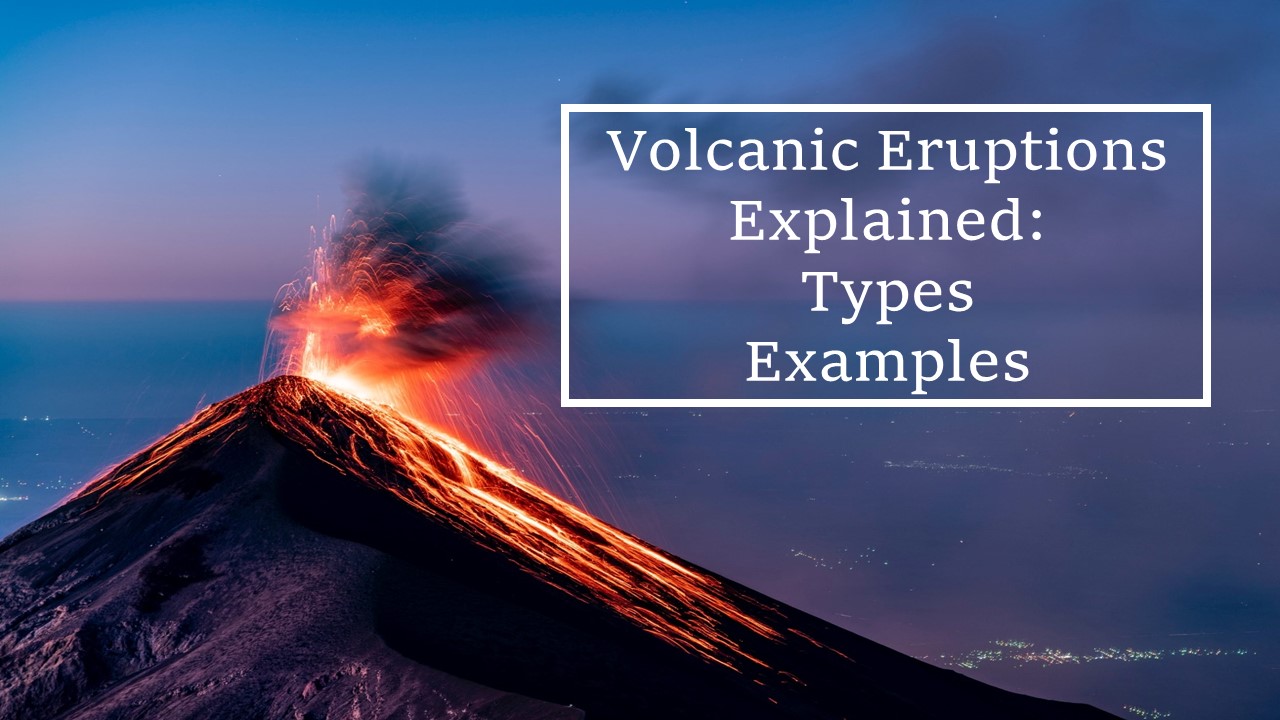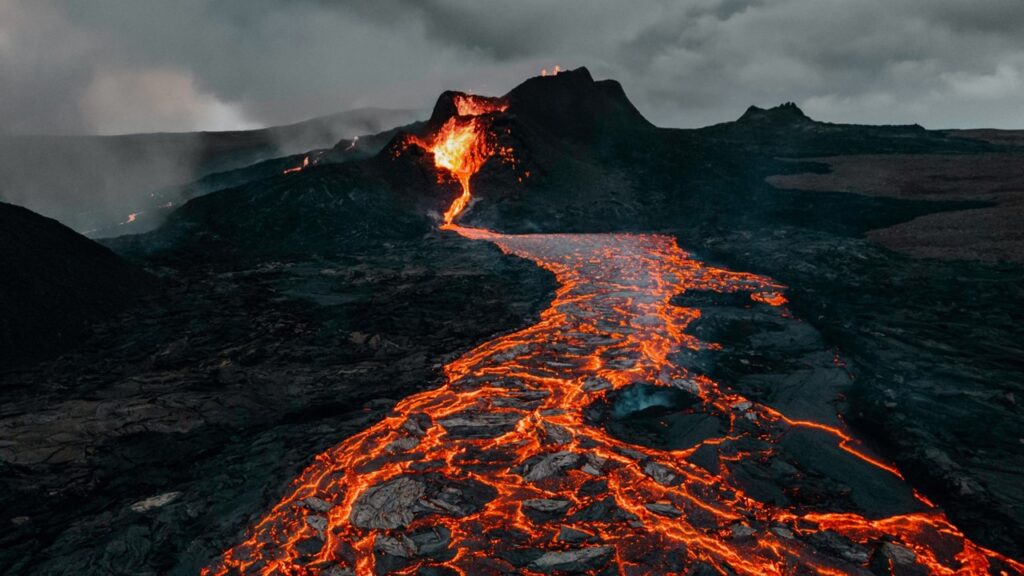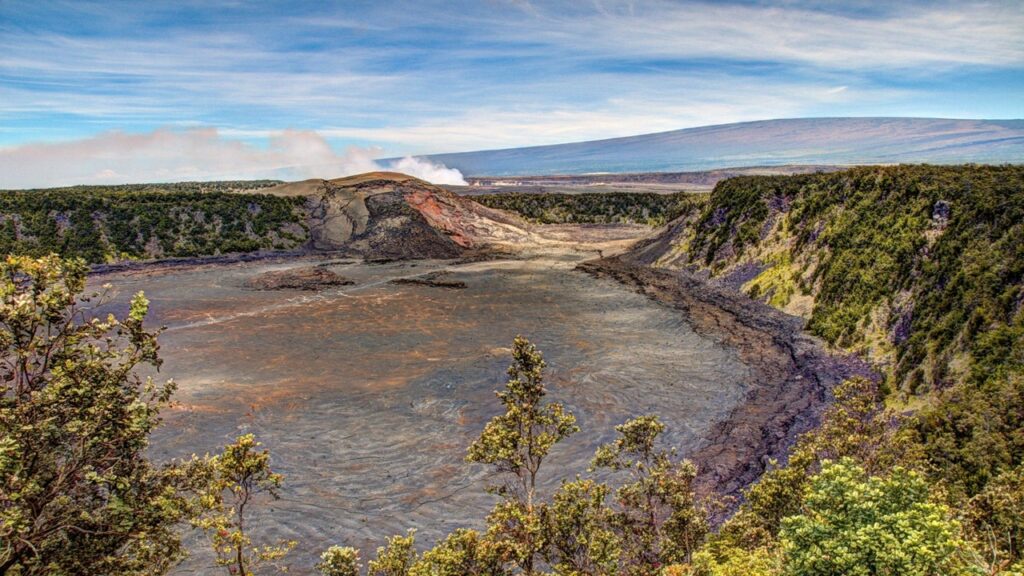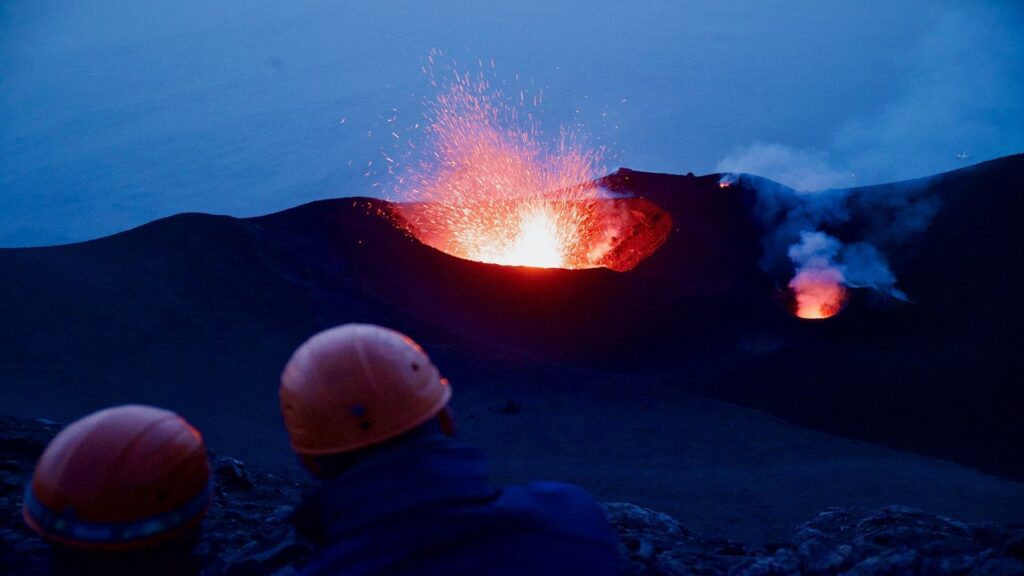Volcanic Eruptions Explained: Types and Examples

Earth, as we know it today, is majorly a product of volcanic eruptions over billions of years. It is in fact such eruptions that have created our atmosphere and oceans. So, life was able to evolve thanks to this juicy soup of elements.
What is a volcano?
A volcano is typically a vent or an opening on Earth’s surface where lava, volcanic ash, and gases come out. The opening typically looks like a bowl-shaped hole at the top of a mound or mountain. It is connected to a storage area of molten rock called magma within the volcano through a number of cracks.
How does a volcano erupt?
A volcanic eruption occurs when magma spurts out of a vent from the Earth. Magma is typically a mixture of chemicals like calcium, and magnesium, rocks, and dissolved gases. It is lighter than the surrounding rocks and sometimes pressure from its dissolved gases pushes it upwards.
In this way, it pours out of weak places of Earth’s surface, hence called an eruption. We refer to the magma that flows out of the vent as lava. Over time, this lava solidifies into rocks and then breaks down into very fertile soil.

How long does it take for lava to cool down?
How long lava cools however depends on many factors. It includes primarily the thickness of the lava flow and weather conditions like wind, temperature, and rainfall. Based on Kilauea’s 2018 eruption and lava cooling rate calculation, scientists estimate that
- Flows 10-15 m thick can take 8-18 months,
- 20-30 m thick flows take 30 months to 6 years and
- Flows 55 m thick might take more than 20 years
to solidify.
For example, in 1959, Kilauea Iki erupted forming a 135 m deep lava lake that took 35 years to solidify. As it is, the middle of the lake could be still hot today. We notice this especially on rainy days when steam rises from the crater floor of the Kilauea Iki.

Eruption of magma
Magma spurts from a volcano in different ways. It can glide smoothly as thick lava flows. Or sometimes, it can be a violent eruption shooting dense clouds of smoke, volcanic ash, and gases into the air. Winds can then transport these particles very far away from the place of eruption before they fall to the ground.
Gases that escape during a volcanic eruption
The main gases that escape during a volcanic eruption are water vapor, carbon dioxide, Sulphur dioxide, and hydrogen halides.
While water vapor is relatively harmless, the other gases are potential hazards. For instance, carbon dioxide is a greenhouse gas that enhances climate change. Sulphur dioxide and hydrogen halides mix with rain to form acid rain that erodes structures and kills crops.
Types of volcanoes
Though we generally associate volcanoes with dome-shaped mountains, there are different types of volcanoes. It generally depends on
- How viscous the magma is,
- The composition of the magma,
- How the magma reached the surface and
- The amount of gas in the magma.
So, we typically categorize volcanoes into two main types: shield and composite volcanoes. When these erupt, they form different features like lava domes and cinder cones.
1. Shield volcanoes
Shield volcanoes are the most common types of volcanoes in the world. Runny lava erupts from the surface and gently glides down the slope of the volcano. In this way, it forms a broad base that can extend over large areas. The largest volcano in the world, Hawaii’s Mauna Loa is an example of a shield volcano.
2. Composite volcanoes
Composite or stratovolcanoes typically have steep slopes and as such are more cone-shaped. The lava that flows out is generally quite sticky and does not flow easily. Consequently, it accumulates near the surface of the crater and forms steep sides.
Additionally, as gas builds inside the thick magma, stratovolcanoes often have explosive eruptions. Perhaps one of the most common examples of a composite volcano is Mount St Helens in the United States.
3. Lava dome
A lava dome is just an accumulation of lava on the vent of a composite volcano. As the lava is thick, sometimes it accumulates on and around the vent covering the surface of the opening. For example, following the eruption of Mount St Helens in 1980, an 850 m wide and 220 m high dome formed in its crater.
Very often, a lava dome looks like a spine or muffin top. Nonetheless, it can be quite dangerous. Fresh magma can fill up the veins of the volcano and exert pressure on the dome. As a result, cooler rocks that are outside shatter and gases spurt out violently.
Types of volcanic eruptions
Basically, there are six types of volcanic eruptions. These are
Hawaiian, Surtseyan, Vulcanian, Plinian, Pelean, and Strombolian volcanic eruptions.
1. Hawaiian volcanic eruption
In a Hawaiian volcanic eruption, fluid basaltic lava spurts out of a vent or through fissures on the flank of a volcano. We also refer to this type of eruption as fire fountaining. It can last for hours and sometimes days. As the lava is quite fluid, it can travel over long distances before it cools down.
A typical example of a Hawaiian eruption is that of the Kilauea Volcano on Big Island, Hawaii. Hence its name also. Majestic lava fountains well over one thousand feet were visible during one such eruption in 1959.
2. Surtseyan eruption
A surtseyan volcanic eruption typically occurs when magma or lava explodes in water. It occurs mainly when a submarine volcano grows enough to break the water’s surface. During the eruption, water that is in contact with the hot lava spews out creating plumes of steam, ash, and rocks.
A classic example of a surtseyan volcanic eruption is that of Surtsey, a volcanic island off the south coast of Iceland. Hydromagmatic activity built up in the volcano between 1963 to 1965 until it exploded.
3. Vulcanian volcanic eruption
The name vulcanian comes from the Italian Island, Vulcano. Back then, people thought it was the vent of the forge of the Roman God of Fire and Forge, Vulcan.
Vulcanian eruption generally occurs when a lava plug inside a crater or a lava dome explodes. It is typically a short and violent explosion of thick magma but can be quite fast and reach great heights. It produces ash clouds, tephra, and gas.
4. Plinian volcanic eruption
Plinian eruptions are the most violent and dangerous type of volcanic eruptions. The eruption generally looks like a mushroom or an Italian pine tree. The Roman historian, Pliny the Younger, made the reference when viewing the 79AD eruption of Mount Vesuvius. So, Plinian eruptions were named after him.
Plinian eruptions occur when gassy magma fragments releasing large amounts of energy. Columns of gas and ash can rise up to 50 km high and ash can drift thousands of miles away from the volcano.
5. Pelean volcanic eruption
A pelean eruption is an explosive outburst of dense mixtures of volcanic ash, gas, and pyroclastic flows. The slurry is quite fluid and so flows down valleys quickly. As a result, pelean eruptions can be quite destructive.
The name comes from the destructive explosion of Mount Pelee in Martinique in 1902 killing 30,000 people.
6. Strombolian eruption
Strombolian eruptions are typically short bursts of glowing lava. They are especially spectacular at night when the lava glows. Strombolian eruptions occur when large gas bubbles that travel in the magma conduit burst when they reach the summit of the volcano.
Strombolian eruption gets its name from the Italian Island, Stromboli which has a number of erupting summits.

Location of volcanoes
Typically, the majority of volcanoes in the world, around 60%, exist along the boundaries of tectonic plates. They conglomerate particularly in the Pacific Ocean, a region called the Ring of Fire or the Circum-Pacific Belt. The Ring of Fire is a horseshoe-shaped belt that extends from the coast of New Zealand to Antarctica to the tip of South America. Due to high seismic activity in that region, earthquakes also frequently occur there.
Volcanoes also emerge from the middle of some plates. This typically occurs where a zone of magmatic activity pushes through the surface. We call them ‘hotspots’. Many small volcanic islands like Hawaii and Mauritius have formed in this way.
How many volcanoes are there in the world?
From the poles to scorching deserts to the submarine surface, volcanoes are spread everywhere around the globe. However, it is difficult to exactly estimate how many actually exist.
For one, there can be some disagreement on the definition of ‘volcano’ itself. For example, a volcano with many fissures where lava flows out but one magma chamber only may not be a ‘single’ volcano. Also, we currently lack data on the number of submarine volcanoes.
So, counting terrestrial volcanoes only, there are around 1500 globally. Most of the active volcanoes are on the Ring of Fire. Consequently, volcanic eruptions often occur in countries that line the belt of the Ring of Fire like Panama, Japan, the Philippines, and Tonga.
